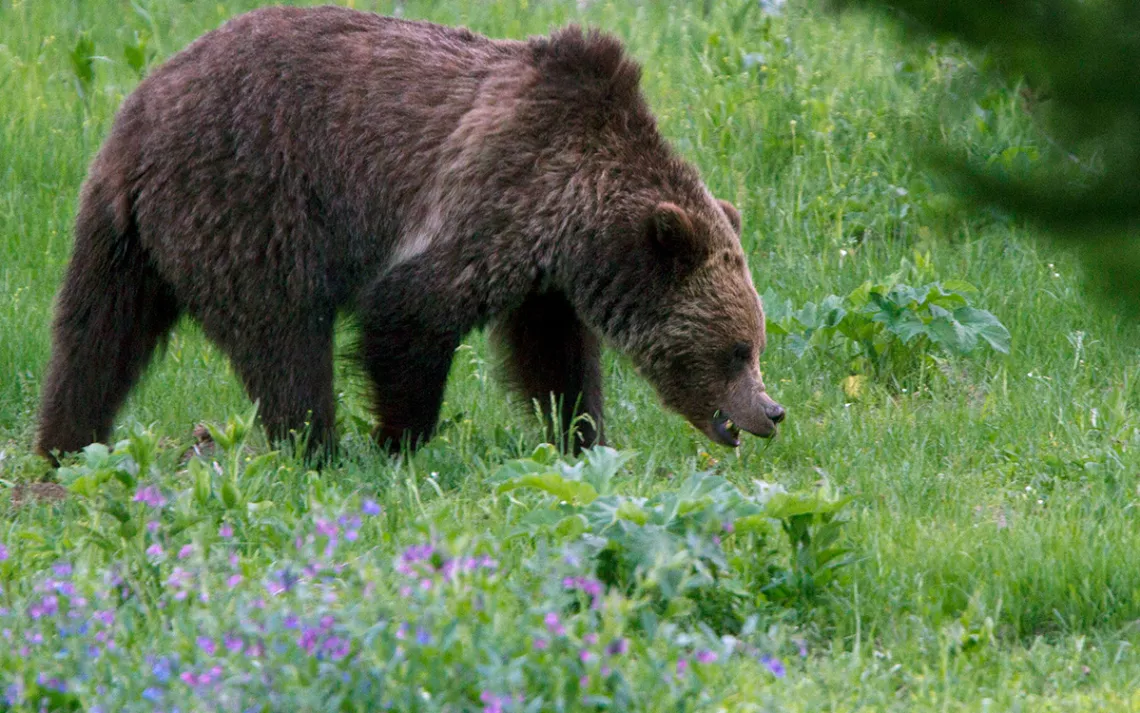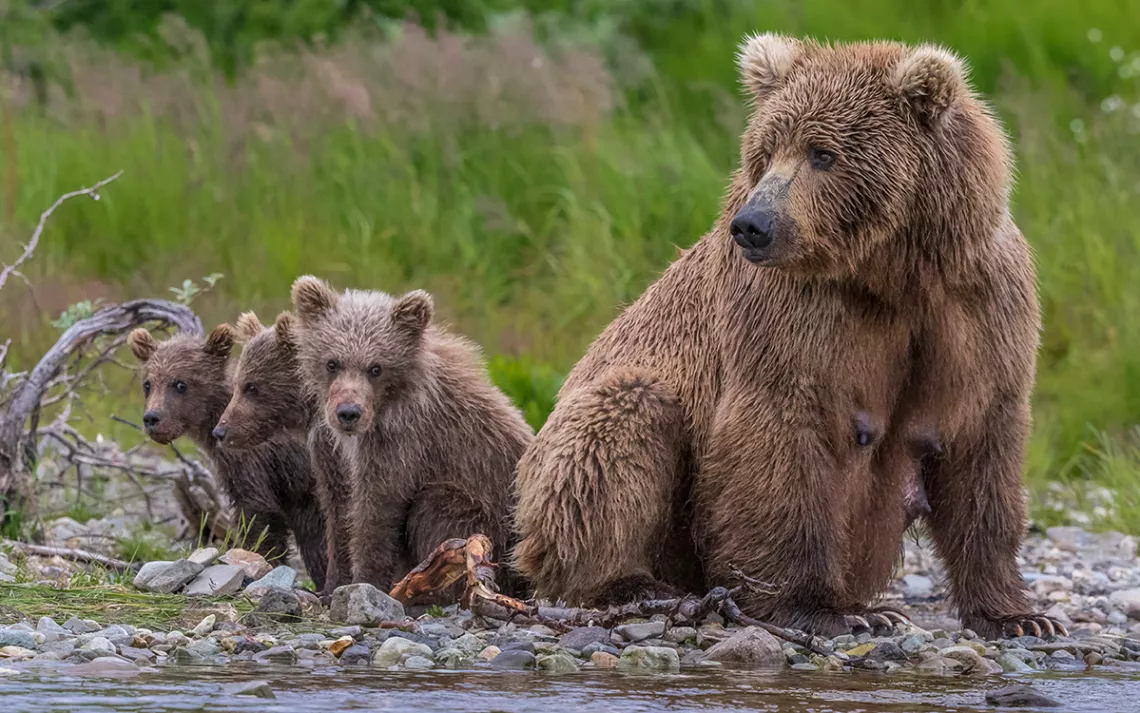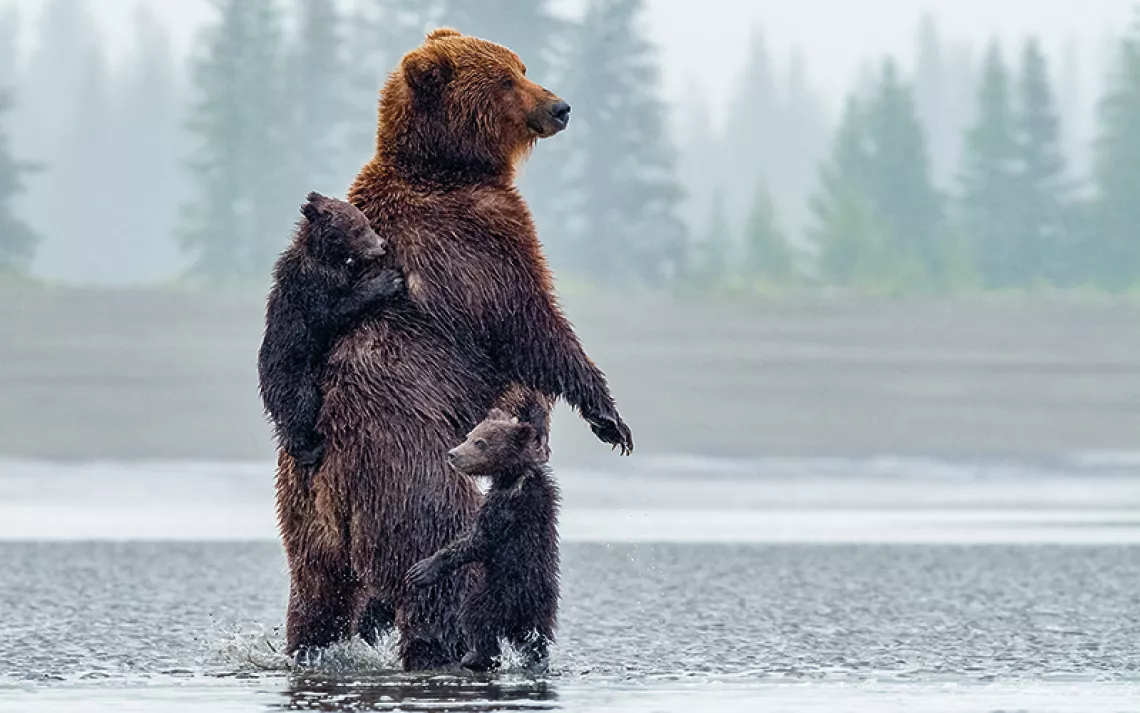Grizzly Bears Are Making a Comeback—and Making Their Human Neighbors Nervous
In the Northern Rockies, biologists are working hard to reduce conflicts between humans and the region's growing bear population
Grizzly bears are hiding in the cornfield. This 100-acre swath of grain in the shadow of Montana's Mission Mountains is surrounded by an electric fence that is supposed to be bear-proof. Except the bears found a gap, and now they don't want to leave. There's no telling how many are hidden within the corridors of tall, green stalks. It's September, the cusp of hibernation season. The bears are hungry, and corn is an irresistible temptation.
I'm driving through the field with Stacy Courville, a wildlife biologist with the Confederated Salish and Kootenai Tribes. Ahead of us appears a long, aluminum cylinder, like the wingless body of a small plane, resting on a wheeled trailer and emblazoned with the words "Danger. Bear Trap. Keep Away." As I open my door, Courville says, "The bears could be right here. Grab a spray."
I pull a canister of bear spray from the truck door and step out. Bear sign is everywhere—kernel-filled scat among crushed cornstalks and partially eaten ears, huge paw prints in a mud patch—but the trap is empty. Courville points across the road to where cattle graze in a pasture. He saw three grizzlies there at dawn, feeding on a fresh carcass in a rancher's "dead pit"—a designated spot for dumping the bodies of livestock that have died of natural causes. Beyond the pasture is Millie's Woods, a forested area where the bears bed during the day.
"So you think there are grizzlies in there right now?" I ask.
"I know there are grizzlies in there right now," he says.
Courville's job is to help people and bears avoid conflict on the tribe's 1.4 million acres, which stretch from high, arrowhead peaks to the increasingly developed ranch- and farmland of the Flathead River valley. Courville has been on the job for 22 years; his work has only become tougher over time. Grizzlies that once kept mainly to mountains and foothills are now following creeks curtained with trees and shrubs down to the river and beyond. Someday, with any luck, they'll connect with the remnant population in Idaho's panhandle and perhaps repopulate the Bitterroot Mountains to the south.
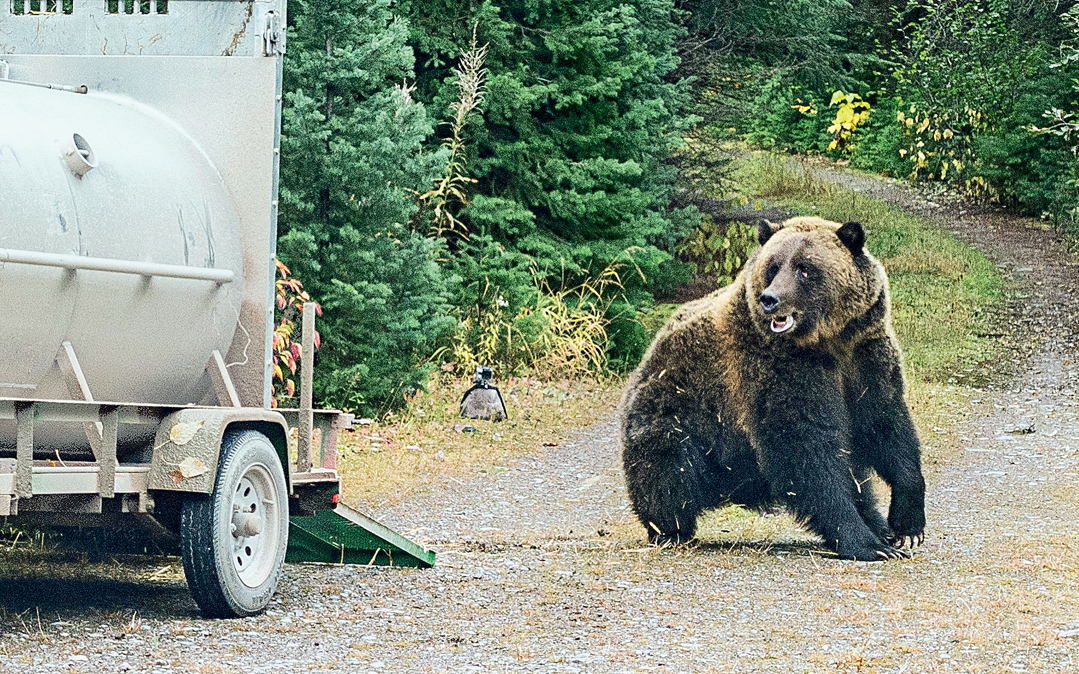
A grizzly shortly after being released into the wild. | Photo by Aaron Teasdale
An estimated 50,000 grizzly bears once roamed the western half of North America, from Canada to Mexico, the Pacific Coast to the Great Plains. By the time they were listed as threatened under the Endangered Species Act in 1975, only 800 or so remained in the Lower 48, and they had been eliminated from 98 percent of their historic range. Today, thanks to legal protections, they number close to 1,800, and the U.S. Fish and Wildlife Service is proposing removing endangered-species protections for Yellowstone grizzlies (see "The Future of Yellowstone's Grizzlies," below). The rush to delist notwithstanding, the bear's comeback is a roaring wildlife conservation achievement.
Yet the grizzly has become, in a way, a victim of its own success. As the bears' numbers have grown, their range has expanded. The bears are moving into populated valleys and plains they haven't inhabited in a century. This sounds great from afar, but how would you feel about one of them in your backyard? Magnificent though they are, grizzlies make for troublesome neighbors and lousy houseguests. The giant animals are routinely spotted chowing on orchard fruits and scavenging pet food and garbage. They're omnivores that like to eat many of the same things people do—chickens and sheep, for example. They search for fish in the same creeks prized by anglers.
In the best cases, this leads to peaceable, never-to-be-forgotten interactions. Mama and cubs roaming lakeside in the early morning, say, or a curious yearling ambling across a meadow. To spot a bear in the wild is to be shocked by the power of another ordinary being going about its business.
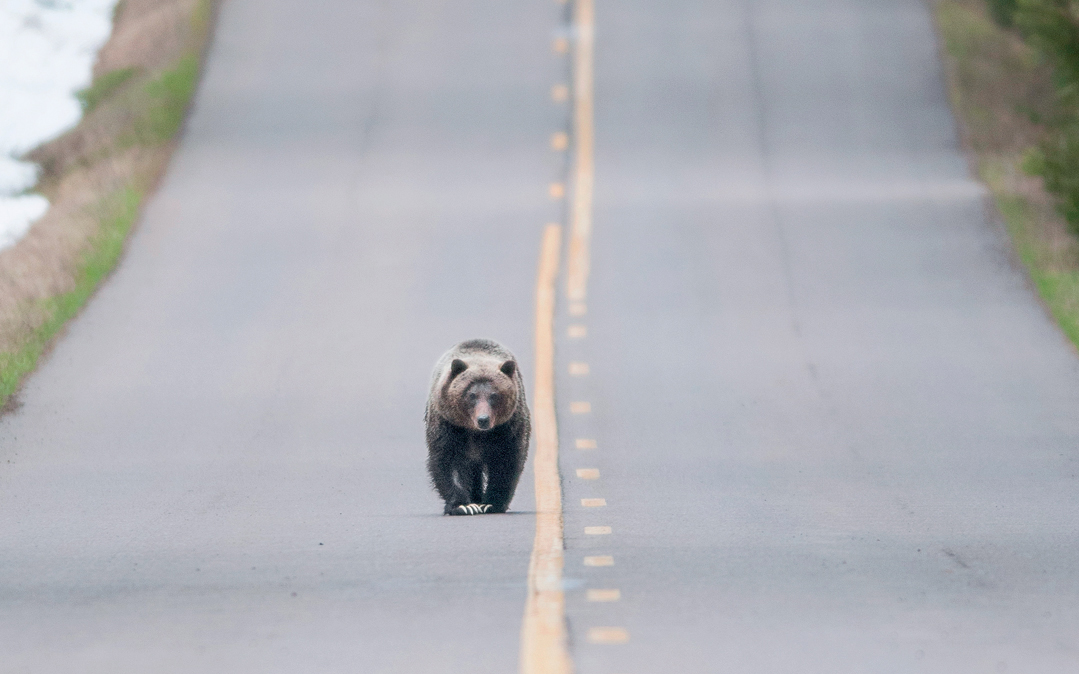
A grizzly bear ambles through Glacier National Park. | Photo by Chris Peterson
But sometimes bear encounters become conflicts and the conflicts become deadly—usually for the bears. If a grizzly becomes conditioned to human food sources, oftentimes it is euthanized. "Once they get started on chickens," Courville says, "they're usually a lost cause."
Since 2010, Courville has had to remove 18 grizzlies from the wild. Some were put down, some sent to zoos. It doesn't have to be this way, though, he insists. To avoid trouble with people, grizzlies in the Northern Rockies have adapted. Normally a diurnal species, they've become nocturnal in the populated lowlands. "They own the valley at night," Courville says. "People here would be amazed how close bears are to them."
But many of the region's human residents haven't made accommodations for their ursine neighbors. Courville says too many people refuse to secure their garbage, dog food, and animals until they have a problem, at which point it's too late. As grizzly and human populations increase in the Mission Valley, Courville's "conflict calls" are increasing.
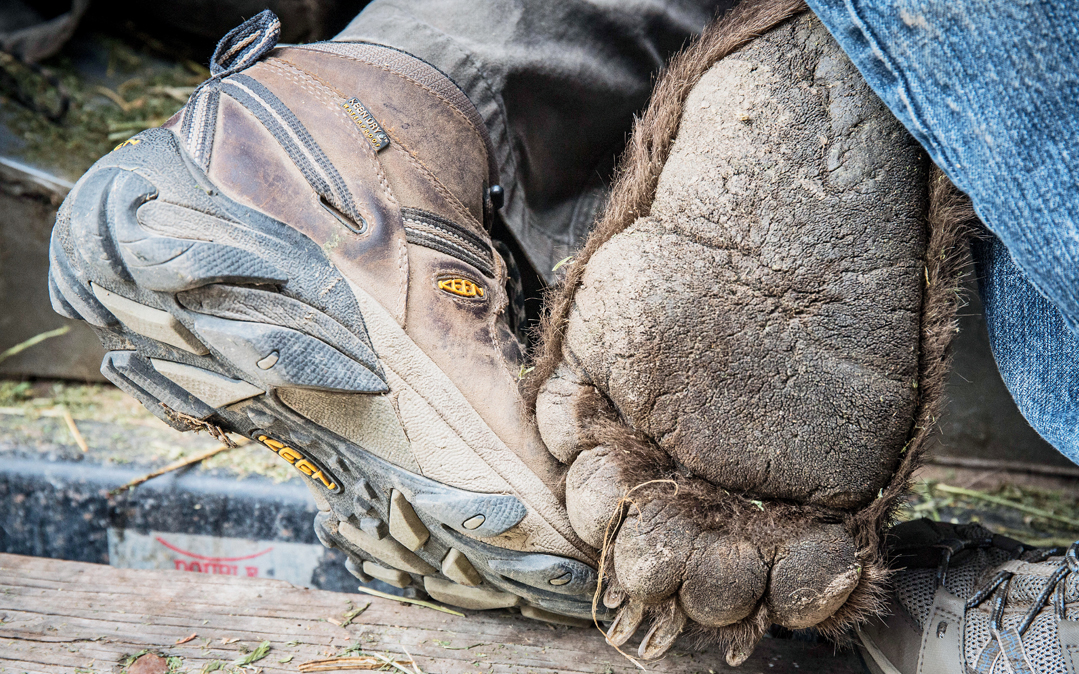
Biologists in Montana are busy trapping, sedating, and relocating bears to prevent lethal human-grizzly conflicts. | Photo by Aaron Teasdale
The long-standing controversies surrounding grizzly bears—to protect or not, whether and how best to manage them—are often reduced to a question of habitat. Both of our species are competing for the same range, and supposedly it's a zero-sum game. But, as Courville and other wildlife biologists argue, it's less a question of suitable bear habitat than it is an issue of bear-human cohabitation.
Is it possible for two intelligent, omnivorous, top predators to coexist? The burden of this challenge falls mostly on us humans. After all, the grizzlies are just being grizzlies: roaming, inquisitive, ever on the search for nutrients. We're the ones possessed with the gift of choice.
"I don't have a bear problem," Courville tells me as we leave the farmer's cornfield. "I have a people problem."
♦
Last September, I headed into the heart of American grizzly country to explore what bear-human coexistence might look like. My road trip took me on a winding, 500-mile, clockwise loop from my hometown of Missoula, Montana, to the edge of Glacier National Park; through the Rocky Mountains and across the Continental Divide at Marias Pass; and down to the farming communities of Choteau and Dupuyer on the Great Plains, where grizzlies have begun to recolonize. This area is what scientists call the Northern Continental Divide Ecosystem, and it's among the most intact wildlands in the Lower 48. The 96,000-square-mile tangle of rugged mountains, rivers, forests, and grasslands includes the Mission Mountains in the southwest, the massive Bob Marshall Wilderness Complex in its center, and the bear-packed wildlife nursery of Glacier National Park as its crown. For a century, it's been the grizzlies' last, best refuge. Now, with a population of over 1,000 grizzlies spilling out in all directions, it's become a testing ground for humans' struggle to live in peace with the great bear.
For years, the prevailing view among biologists was that grizzlies were wilderness animals that needed untouched habitat far removed from humans. But thanks to the advent of location-tracking GPS collars, biologists in the last decade have gotten a lesson on the bear's versatility. It turns out many of them actually live almost entirely in the valleys, close to human development.
Sometimes, surprisingly close. Rolling up to Tim Manley's house in a rural subdivision between the towns of Whitefish and Columbia Falls, 20 miles from Glacier National Park, I know I'm at the right place when I see a bear trap in the front yard. Manley is the region's longtime grizzly bear management specialist (for Montana Fish, Wildlife, and Parks, a.k.a. FWP), and when I arrive, he and his young assistant, Daniel Madel, are preparing sedatives. They tell me that there's a grizzly in the trap, one they captured after it killed seven chickens in an unsecured coop outside the town of Coram. I step over to the trap and look through the bars.
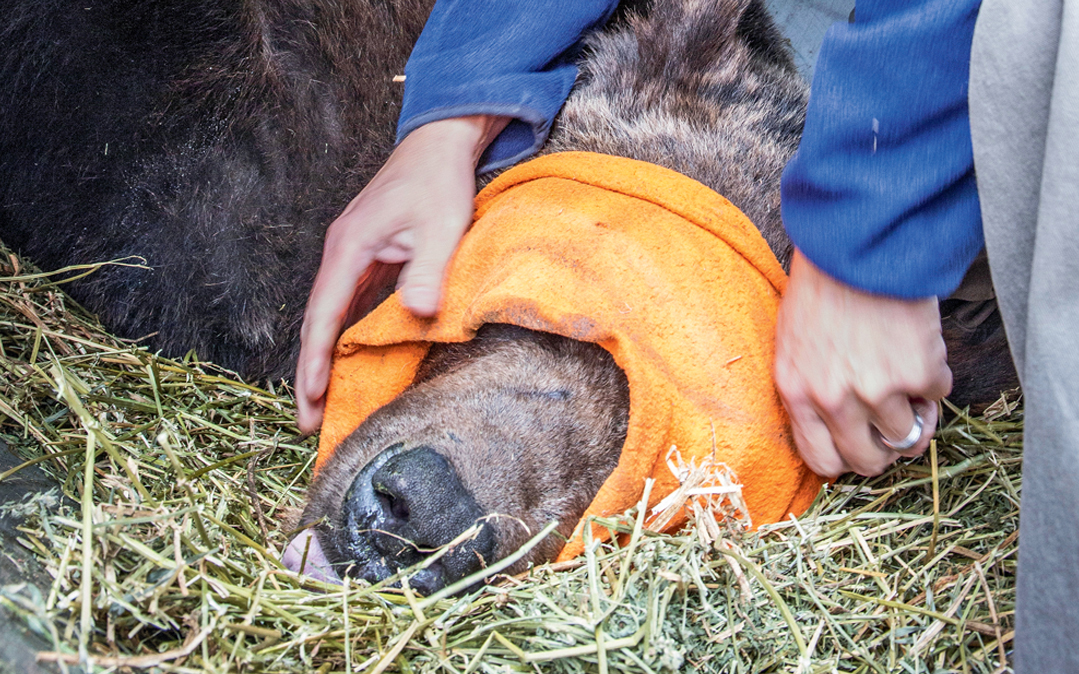
Tim Manley—longtime grizzly bear management specialist for Montana Fish, Wildlife, and Parks—studies a sedated bear. | Photo by Aaron Teasdale
A remarkably calm grizzly bear with an enormous head sits there peacefully like an ursine Buddha. It turns its giant head, our eyes join, and for a moment the world collapses. Never have I been this close to a wild grizzly bear.
This is nothing new for Manley. The genial 57-year-old has been working with grizzlies since 1984, and this is the 218th bear he's trapped. With the cool of a pool shark, he sticks a metal rod tipped with a Telazol-filled syringe through the trap's bars and jabs the sedative into the bear's neck. Fifteen minutes later, I'm helping pull the unconscious grizzly out onto the ground. Its fur is coarse, its body heavy and warm.
"It's an old bear," Manley says, as he pulls back the animal's lips and examines its teeth, many of which are entirely worn away. "Over 20 years old."
He puts ophthalmic ointment in its eyes for moisture and protection before pulling a soft cotton sleeve over the bear's face. Now he's waving an electronic sensor over its ears and head. "It's chipped," he says, meaning it's been trapped before and has a rice-grain-size identifying microchip embedded under its skin. He and Madel exchange a knowing glance, and Manley heads for the laptop in the cab of his truck. They suspect the bear might be wanted for manslaughter.
On June 29, Brad Treat, a 38-year-old U.S. Forest Service law enforcement officer and former Glacier National Park ranger, was mountain biking with his nephew near the park when he came around a bend and collided with a grizzly. The bear set upon Treat, and his nephew fled. When law enforcement and Manley arrived on the scene, they found Treat's mauled body. It was the first grizzly-caused fatality in the area in nearly 20 years.
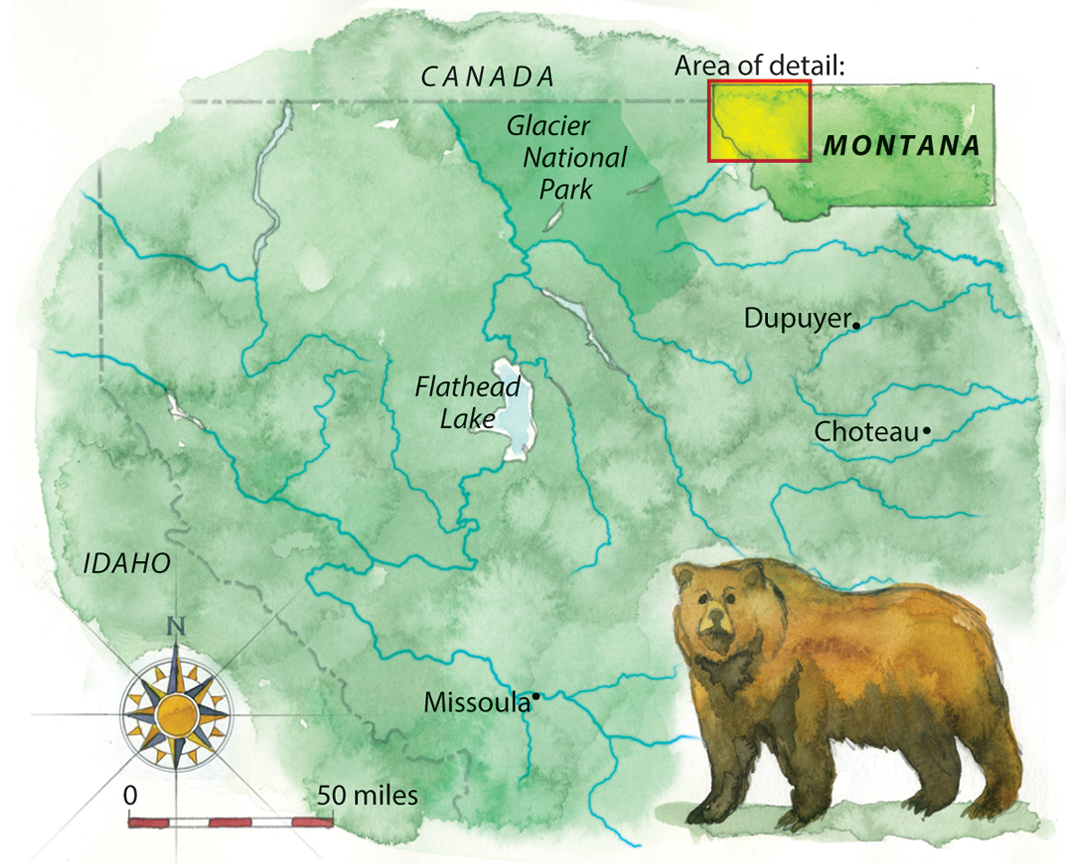
Map by Steve Stankiewicz
♦
Despite a prolonged search, the bear was never found. DNA testing on hair gathered from the site showed it was a bear that had been captured before. It carried a chip and was more than 20 years old. The sedated bear at my feet was captured 4.5 miles from the site. Is this the grizzly that killed Brad Treat?
The possibility hits me like a weight. I hurry to the truck, where Manley is intently scrolling through a database. "It's not the same bear," he says. The weight lifts. I don't want this beautiful bear to be killed.
As it turns out, this is the fourth time Manley has trapped the bear. It's a 22-year-old called the Abbot Male. After fitting it with a GPS collar and taking a blood sample and a variety of measurements, we push the old male, which we now know weighs 412 pounds, back into the trap before he wakes. As we heave, my hands on his warm belly, he lets out a deep rumbling breath.
Then Manley's phone rings. It's Tim Thier, another area wildlife biologist. He's just caught a grizzly, too. We hop into Manley's truck and head north. An hour later, we pull up to Thier's backwoods home at the end of a long dirt driveway about 25 miles from the British Columbia border. A low growl emanates from a nearby trap. I lean my face toward the bars to see this new grizzly. It lunges at me with a roar, its canines bared. I jump backward as its four-inch claws slice between the bars, the entire trap rocking. Manley says it's more of a "wild bear" than the Abbot Male.
Thier, lanky and gregarious, comes out of his house. He says he caught the bear on the edge of the town of Eureka, where grizzlies had recently been spotted along the river walk. "Within 10 miles of town, I don't know if we got two or 10 grizzlies," Thier says. "This time of year, you encourage people to pick their fruit, to make sure they have everything clean, no garbage out, no pet food of any kind. If they got chickens, make sure they're hot-wired [behind an electric fence]."
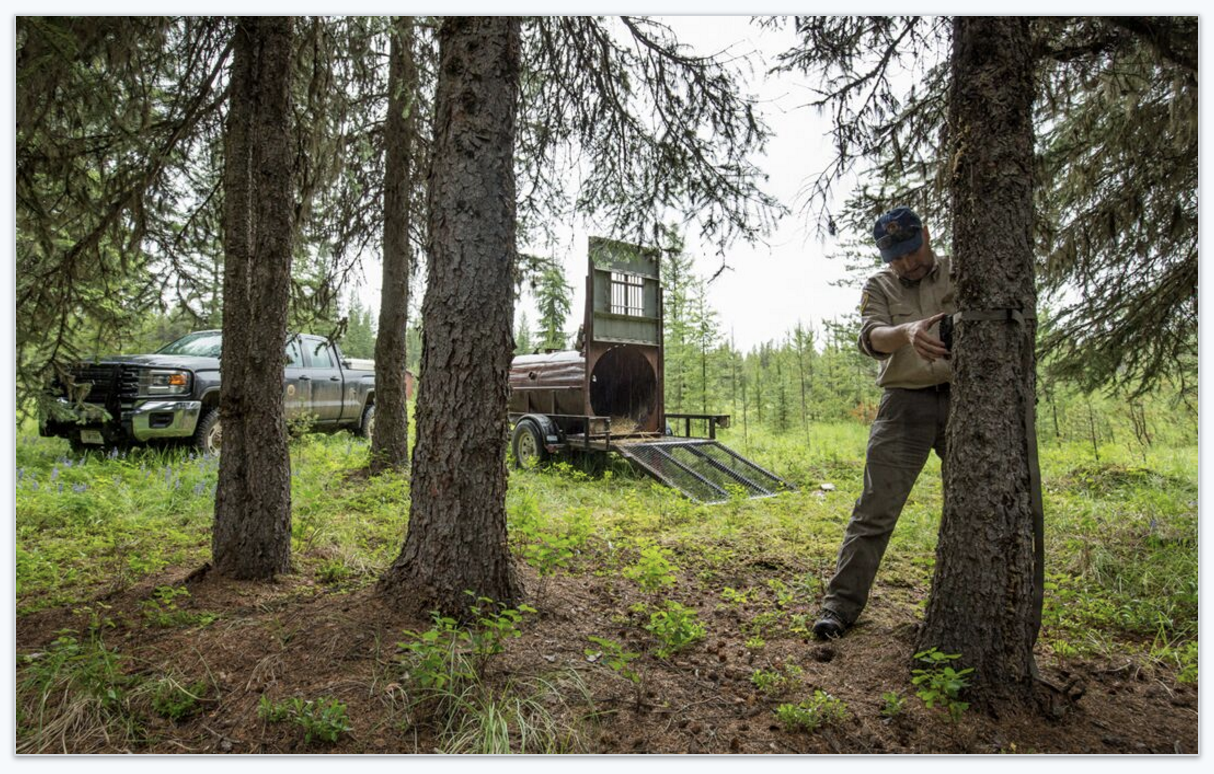
Montana grizzly bear biologist Tim Manley adjusts the motion-activated camera near a bear trap. | Photo by Aaron Teasdale
He says it was a shame to trap it, but a grizzly had broken into a shed for pet food, and one was seen feeding on a deer carcass just off the river path. There's a risk the grizzly is becoming habituated to human food. "It's right in town, right where all the people are," Thier says. "They look at us to keep them safe, and so that's what we want to do."
As soon as the sedated bear is out of the trap, Thier and Manley are inspecting her. Thier pulls back her lips to look at her teeth and says, "About five years old." A quick examination of her nipples confirms she hasn't had cubs yet, but there's speculation that she might give birth in her den this winter. She weighs 334 pounds. She has no chip. She hasn't been in trouble before. Her thick coat has a striking, golden band around her shoulder hump. They decide to name her Purdy, which is both descriptive and the name of the caretaker of the property where she was captured.
On the drive back south, Manley explains that the trapping and eventual release is a form of aversive conditioning. "It's a bad experience, hopefully, for her."
The next day, we head north under gray skies into the Whitefish Range—remote, undeveloped mountains—to complete some of that aversive conditioning. Manley and Madel each drive a truck towing a grizzly bear in a culvert trap. We go up rough dirt roads and burrow deep into the forest-clad mountains.
With the trucks strategically parked at the release site for a quick escape, Madel remotely opens the door of his trap, which rises with a loud whir. This is the first release for Purdy. She assesses things and doesn't emerge immediately. When she does burst out, she turns in an instant, like a sumo wrestler with the agility of a gymnast, and momentarily charges at the trap. Then she spins and bolts down the road, taking one last look back before disappearing beyond the trees.
The second bear, the seemingly sedate Abbot Male, is released several miles to the north and explodes from the trap as soon as the rising door allows. Instead of running across Yakinikak Creek as expected, he makes a hard left and flies straight at my camera and tripod. The resultant video is mesmerizing, as the old bear leaps at the camera with an open mouth and worn teeth. He carries the camera a few paces, breathing loudly, before slamming it to the ground and disappearing into the creek bottom.
♦
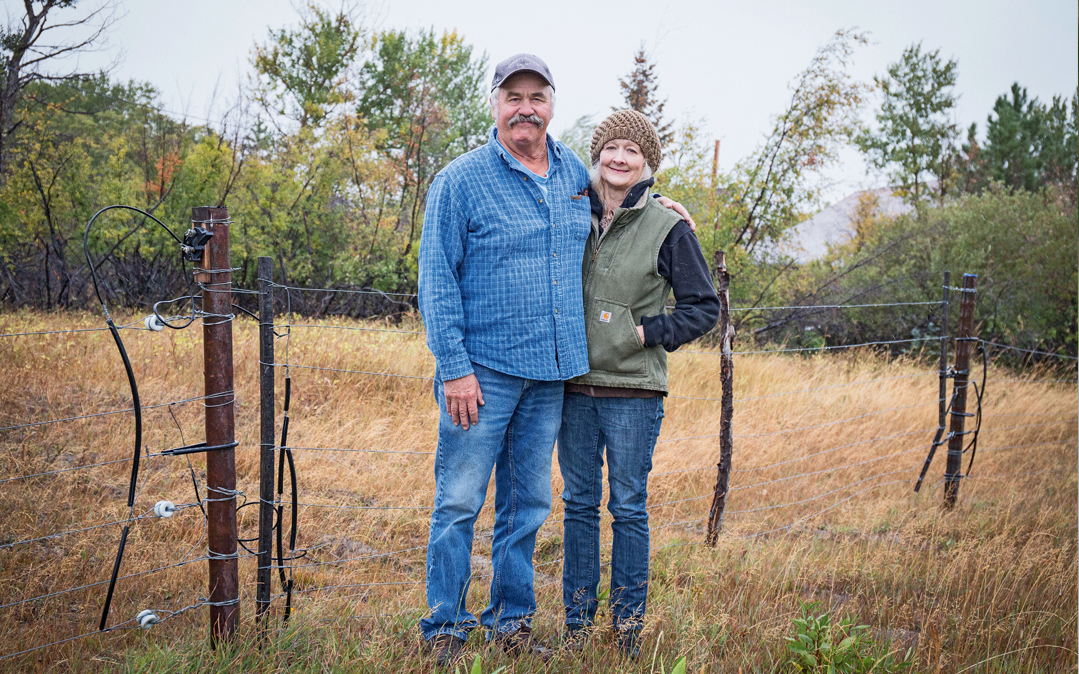
Sheep ranchers John and Leanne Hayne say they are "trying to negotiate living with bears." | Photo by Aaron Teasdale
During the last couple of decades, much to everyone's surprise, grizzlies have returned to the Great Plains. Grizzly bears inhabit the modern imagination as residents of woods and mountains. But before European settlement, the animal's range included grasslands. Lewis and Clark began encountering grizzlies on the prairies of what are now the Dakotas. By the time the Corps of Discovery neared the foothills of the Rocky Mountains, it sometimes crossed paths with multiple brown bears per day. Today, Montana's Rocky Mountain Front is still wild and largely undeveloped—a 100-mile wall of sculpted limestone reefs and peaks that plunge into short-grass prairie. With only scattered small towns, vast ranches, and over 100,000 acres of conservation easements, it's one of the most diverse biomes in North America, and perfect habitat for a clever omnivore.
Except that now the grassy sweeps that teemed with what Lewis called "immence [sic] quantities of game in every direction" are less accommodating to bears. No one knows this better than grizzly bear management biologist Mike Madel, Daniel's father and Montana FWP's first grizzly specialist. Since 1986, he's been working with residents in the tiny farming communities of Choteau, Augusta, and Dupuyer to try to keep bears alive. Tempers ran hot in the 1980s, when grizzlies began coming out of the mountains, following the incisions of brushy riparian corridors onto the flatlands. An argument over grizzlies at a breakfast spot in Choteau once led a game warden to throw a local beekeeper against the wall. A float in the town's summer parade one year featured children behind bars and a sign: "Lock up your kids—the bears are here!" During a public meeting, ranchers threatened to hang the Fish and Wildlife Service's grizzly recovery coordinator.
Madel, agreeable and with reassuringly rugged Marlboro Man looks, was called in by state officials to mollify the situation. For three decades, the tireless 60-year-old has been tracking the area's grizzly population, leading bear talks, working with locals to clean up their properties, and doing everything in his power to teach bears to stay away from residences. Today, Choteau residents have a truce with the grizzlies, but Madel still stays busy nearly every day from spring to fall. His biggest challenge: convincing farmers, ranchers, and homesteaders unaccustomed to grizzlies to keep food sources away from the bears.
Madel's state-issued pickup is packed with bear snares, sedatives, canisters of bear spray, remote cameras, bear warning signs, a shotgun, and, in a kennel, his trusty Karelian bear dog, Birch. We head north out of town on Highway 89, and Madel points out a field where a grizzly with cubs has been seen the last two nights. We pass a spot where he recently saw seven grizzlies feasting on chokecherries.
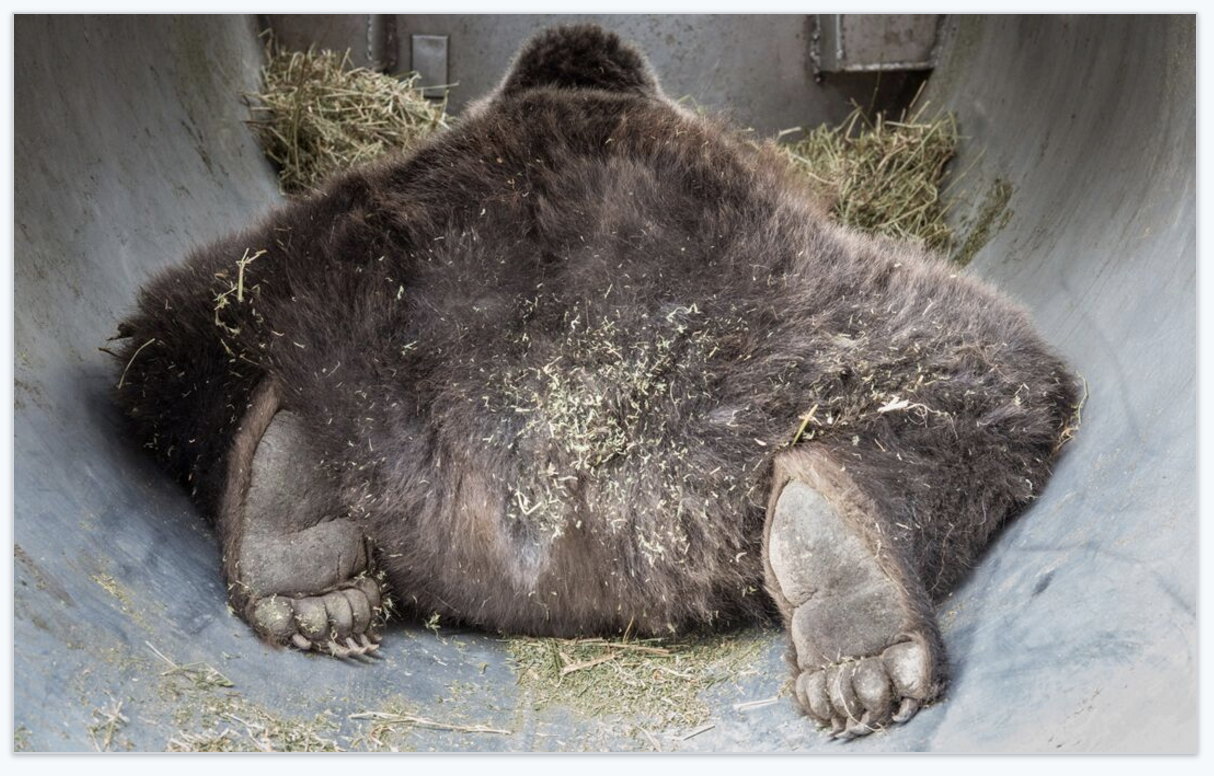
A sedated, 412-pound grizzly is returned to a culvert trap after biologists took measurements, completed a health check, and installed a radio collar to track the bear’s movements. The grizzly was released in a remote location the next day. | Photo by Aaron Teasdale
A few miles outside Choteau, we arrive at a cattle feedlot where grizzlies have been eating leftover wheat kernels. "Spilled grain is a tough issue for us," Madel says as he walks around a cluster of grain bins and checks the voltage on an electric fence that was installed a few days earlier. "If bears keep getting rewarded, they'll just keep coming to feed on this."
Electric fencing is the number one tool bear managers have to deter grizzlies from agriculture operations. But there are always more places that need it. Down a dirt road we come to a clapboard granary with a freshly ripped hole, now patched, at the height of a grizzly bear mouth. A new electric fence girdles its exterior. As he inspects things, Madel notices fresh bear tracks and kicks at grain-filled scat. "They were here again last night."
Another major attractant is dead livestock. Historically, prairie grizzlies fed on bison. Now they rely on livestock carrion for protein. "Every ranch loses half a dozen calves and a couple cows each spring due to natural causes," Madel explains. "Multiply that times 150 or 200 ranches and that's a huge protein source. It's like salmon streams in Alaska."
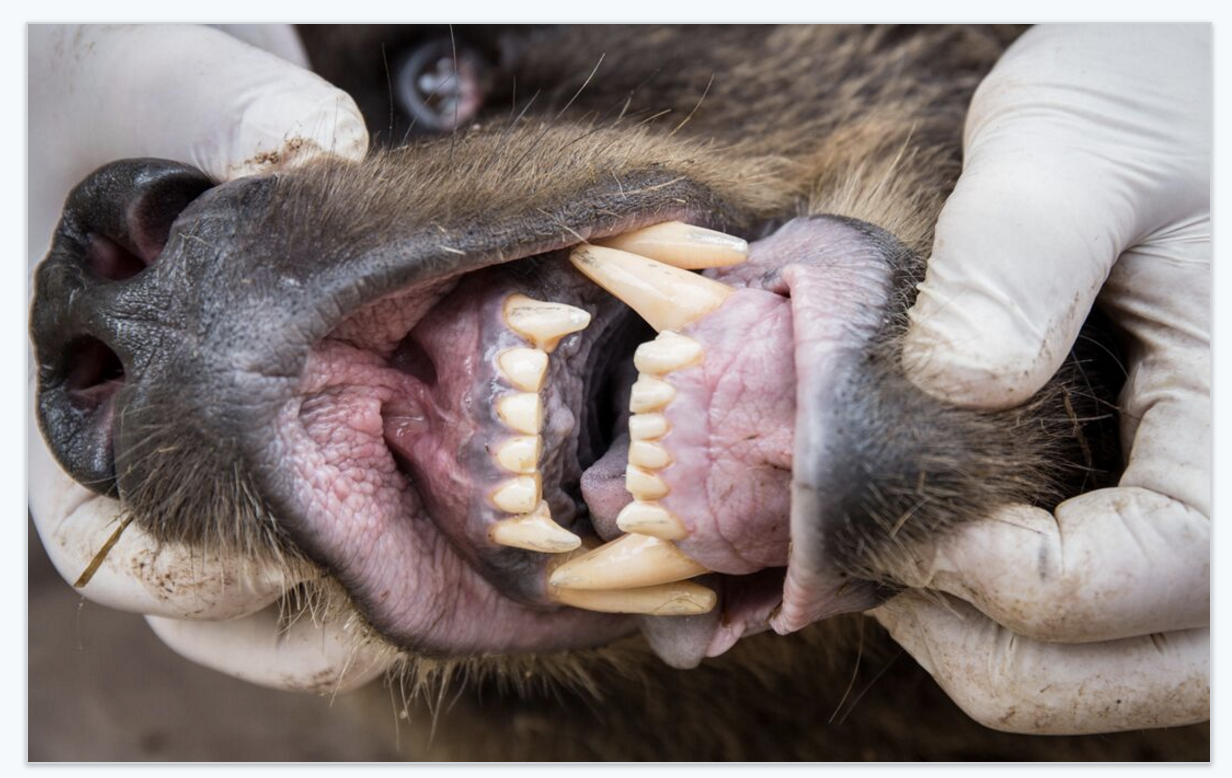
A bear biologist inspects the teeth of a five-year-old grizzly. Bear biologists can measure the age of a bear by the length of its teeth. | Photo by Aaron Teasdale
Madel does not mind grizzly bears tracking down dead livestock—at least not since he convinced almost every rancher on the front to abandon the practice of locating boneyards near their residences, which acted as bear magnets. Today, most ranchers disperse carcasses to various remote locations on their properties.
We hop back in the truck and drive to the one-blink town of Dupuyer (population 86), which has become a micro-model for human-grizzly coexistence. Dupuyer Creek runs along the edge of town, and its profusion of chokecherry bushes provides a travel corridor and an abundant food source for grizzlies. The largest documented grizzly in the Lower 48 was captured here in 2003, an enormous 852-pound male.
Madel shows me the creek underpass that was widened specifically for bears. The creekside town park—"right in the middle of grizzly bear habitat"—has bear-proof garbage cans and a food storage locker for camping tourists. The entire town has secure garbage cans and electric fencing around animals. "Now grizzly bears are moving through all the time, and there are no conflicts," Madel says.
We decide to pay a visit to John and Leanne Hayne, who were both raised here and have a sheep ranch and boutique wool-yarn business. The two 60-somethings are jovial, but when grizzlies first appeared in the 1980s, the couple hated them.
"The girls would be upstairs, Mom, there's a grizzly bear in the yard!" Leanne says. "We had one really bad bear that killed four of our big rams. He killed sheep right in people's yards. He killed two of our llamas, our neighbor's llama."
So the Montana FWP, the USFWS, and the nonprofit Defenders of Wildlife helped the family fence off their lambing grounds, entire house, and yard. It was one of the first electric fences on the front. Overnight, the Haynes could relax in their own home again. Then the bears started eating the sheep in their pasture. While grizzlies generally don't bother cattle, they love to prey on sheep, the marshmallows of livestock.
The Haynes thought about giving up their herd, but John had always been a sheep rancher and Leanne had a successful business selling her yarn all over the world. "We said we'll hang in there. We'll build some electric fences and do the best we can," Leanne says. John became a master electric-fence builder. He now has what Madel calls "probably the second-largest electrified sheep pasture in Montana."
"Now the predation from grizzly bears is almost zero," Leanne says. "They are negotiating living with us, just like we are trying to negotiate living with them."
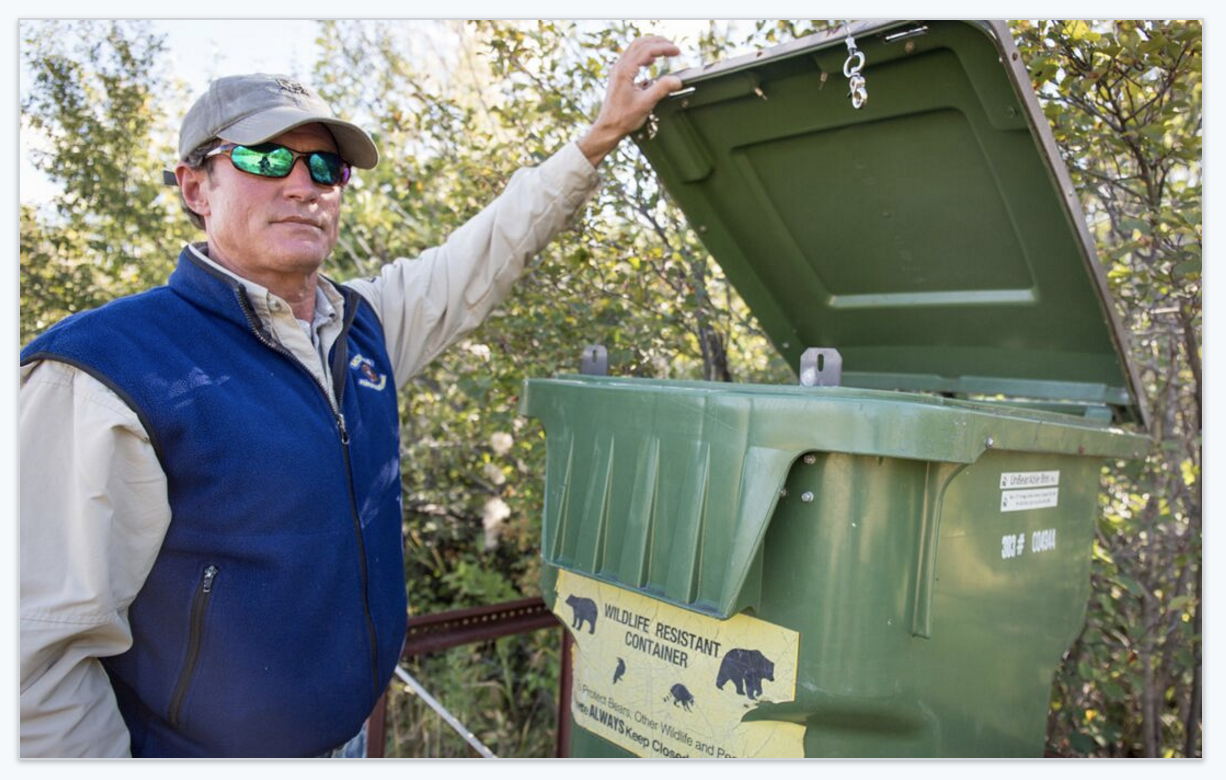
In grizzly country, simple acts like securing garbage can help to reduce bear-human conflicts. | Photo by Aaron Teasdale
What about those grizzlies in the cornfield in the Mission Valley? The farmer began harvesting the following day, and as he drove his combine through the plot, grizzly bears started streaking out from among the stalks. In the end, the farmer left a 30-by-80-yard patch of corn standing unharvested. There were at least four grizzlies inside that refused to leave.
That cornfield is a microcosm of the American West: Grizzlies are here, they're not going away, and we're going to have to get used to them. There's no doubt that this will be challenging. After all, grizzlies demand many things from us. They require us to batten down our homes and farms. They force us to be more wary when we enter the wild. They keep our nerves a bit more active.
But their presence is also a gift. They compel us to pay closer attention to the world. Those of us who live in the Crown of the Continent have to learn what the bears are eating and at what time of year. We become more observant naturalists, watching the earth closely for signs of their passage. A landscape with grizzlies is more dangerous—but it's also more alive. Here we rediscover a lost awareness and remember that we are just one species among many.
"Grizzly bears are showing themselves much more adaptable than we ever would have thought," Mike Madel told me at one point.
The question that occurred to me then remains unanswered: Are we humans willing to adapt to grizzlies?
The Future of Yellowstone's Grizzlies
When grizzly bears were listed as threatened under the Endangered Species Act in 1975, there were an estimated 136 remaining in the Greater Yellowstone Ecosystem, including as few as 30 adult females. From this precarious position, their numbers have recovered to more than 700 today.
The U.S. Fish and Wildlife Service first attempted to remove Yellowstone-area grizzly bears from the threatened-species list in 2005. (Other tenuous populations in Montana and Idaho, and the anchor population in the Northern Continental Divide Ecosystem, have not been proposed for delisting.) Conservation groups, including the Sierra Club, sued the agency. In 2009, a federal district judge overturned the delisting and ruled that the USFWS had failed to consider the impact of dwindling whitebark pine nuts, a key food source for Yellowstone bears.
Then, in 2015, the USFWS presented studies showing that grizzlies had found alternatives to whitebark nuts, and in March 2016 once again proposed delisting Yellowstone grizzlies. The USFWS noted that, since the mid-1970s, grizzlies have more than doubled their range, which now encompasses 22,500 square miles.
Delisting would turn management of the grizzlies over to the three states that contain the Greater Yellowstone Ecosystem—Montana, Idaho, and Wyoming. Ranchers and hunters, powerful constituencies in the region, are enthusiastic about the proposal. Mike Keckler, spokesperson for the Idaho Department of Fish and Game, says delisting is "long overdue. We have a very healthy population."
Bonnie Rice of the Sierra Club's Our Wild America campaign says the USFWS is rushing the process. The states not only want to decrease grizzly numbers, Rice says, but also are opposed to allowing the animal's expansion into historic habitat, even though large swaths of suitable habitat exist—for example, Idaho's vast Selway-Bitterroot Ecosystem. Many biologists say that for Yellowstone's isolated population of grizzlies to survive in the long term, it must connect to the larger grizzly population of the Northern Continental Divide Ecosystem.
"If this rule goes forward as proposed, it's going to mean less grizzly bears in a smaller area than we have now," Rice says. "After spending four decades and countless millions of dollars to recover this population, we think there needs to be a commitment to a stable or increasing population."
In October, over 50 Native American tribes joined with Canada's Assembly of First Nations to sign a treaty opposing delisting and proposing that tribal lands be utilized for grizzly expansion. "We must recognize that this struggle for the protection and preservation of the Great Bear is a struggle for the very spirit of the land," Stan Grier, chief of the Piikani Nation in Alberta, said at the treaty signing. "A struggle for the soul of all we have ever been, or will ever become."
As this issue went to press, the USFWS had not issued a final decision. —A.T.
A Billionaire for the Bears
Ted Turner, founder of CNN and one of the country's best-known conservation philanthropists, is the second-largest private landowner in the United States. His 17 ranches include exceptional wildlife habitat, mainly in the Midwest and mountainous West. While the extent of these personal landholdings is impressive, even more so is how Turner uses them. Rather than building and selling a slew of "ranchettes"—one of the prime factors causing the Greater Yellowstone Ecosystem's habitat fragmentation—Turner has placed his 113,613-acre Flying D Ranch in Montana under a conservation easement with the Nature Conservancy. This allows for both commercial bison ranching and the retention of significant wildlife habitat that benefits everything from elk to wolves to grizzly bears.
As protected areas in the region are increasingly surrounded by development, the Flying D, about 55 miles from Yellowstone National Park's northwest corner, could soon play an even greater role in grizzly conservation. If the Fish and Wildlife Service removes Endangered Species Act protections for Yellowstone-area bears, Turner's private preserve will offer a refuge for the species.
In 1997, Turner founded the Turner Endangered Species Fund to act as a nongovernmental partner to agencies working to recover imperiled species. He recruited renowned wolf expert Mike Phillips, a proven leader in wildlife conservation and the evolving art of "rewilding." Properties like the Flying D offer a "unique balanced tension between conservation and commerce," Phillips tells Sierra. Turner's land management is founded on the idea that humans should seek to fit ourselves into the landscape, rather than forcibly altering the landscape to suit our whims. For example, Turner's reaction to infrequent predation of his bison—last year two grizzlies were filmed feeding on a carcass—is to allow carnivores like wolves and cougars to go about their bloody business without reprisal.
The Flying D Ranch offers what Phillips calls "superb habitat for grizzlies, really a tremendously appropriate setting" due to both its location and its ecological terrain. The brushy hillocks of the Flying D include a variety of terrain in which bears can forage. Grizzlies arriving on the ranch "would think they'd died and gone to heaven," Phillips says. "We deliberately limit the number of commercial bison the ranch could easily sustain, and therefore there's little to no overgrazing, leaving plenty of springtime forage for elk, deer, and bears."
The Idaho, Montana, and Wyoming game agencies are eager to open hunting seasons on grizzly bears if they are delisted. If bear hunting were to resume in the national forests surrounding Yellowstone National Park, the Flying D's fearless brand of wildlife management would make the ranch an essential haven for grizzlies. "Almost by design," Phillips says, "the Flying D promises to play a significant role in the perpetuation of grizzly bears throughout the Greater Yellowstone Ecosystem. If the species is delisted here, the Flying D's importance will only continue to grow." —William H. Funk
On the web Watch journalist Aaron Teasdale's gripping video of a male grizzly bear mauling his camera: sc.org/grizzlycamera.
Be bear-safe What should you do if you encounter a grizzly in the wild? Our expert offers some tips: sc.org/grizzlysurvive.
This article appeared in the January/February 2017 edition with the headline "The Return of the Grizzly."
WHAT YOU CAN DO
Oppose Delisting and Hunting Of Greater Yellowstone’s Grizzly Bears: Thanks to 40 years of Endangered Species Act protections, grizzly bears in the Yellowstone region have made a comeback—but they are still vulnerable and need protection. Send a message today!
 The Magazine of The Sierra Club
The Magazine of The Sierra Club

